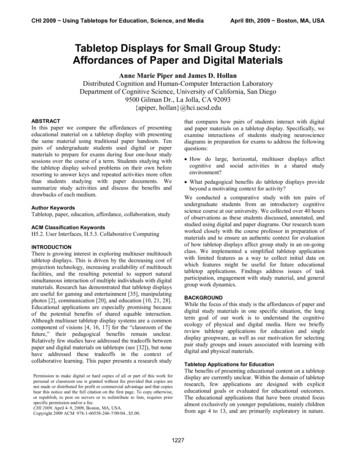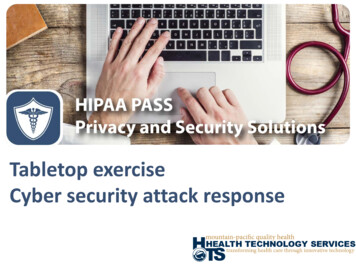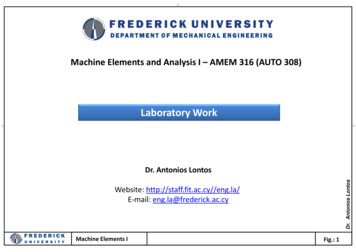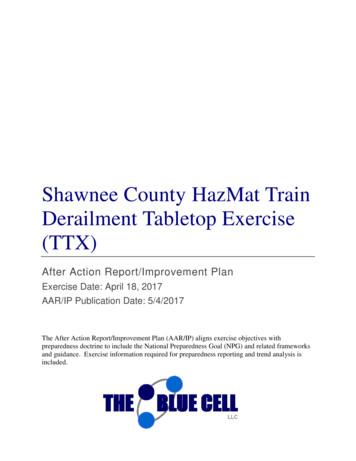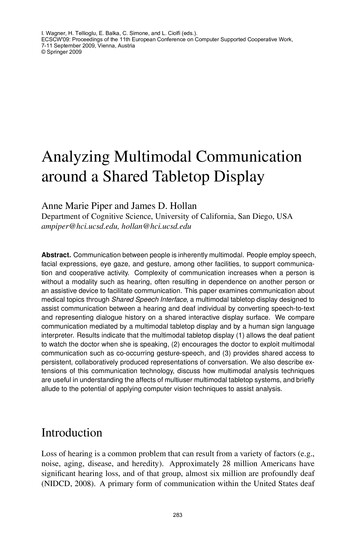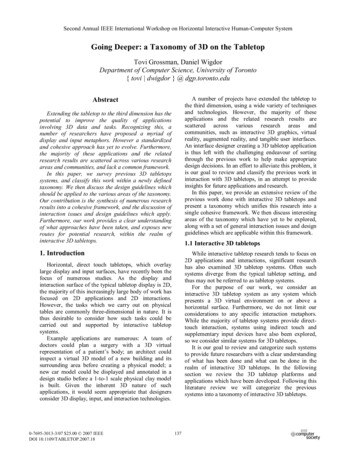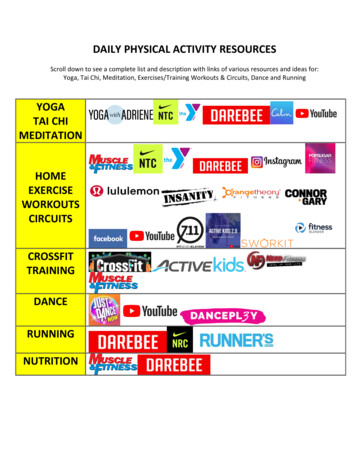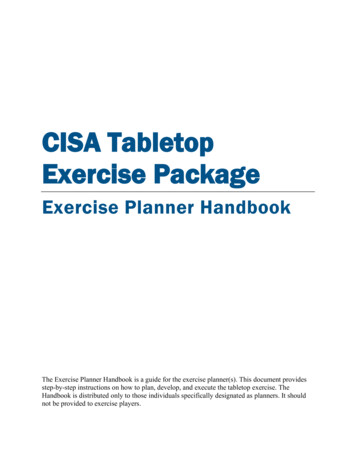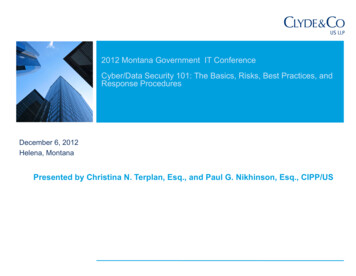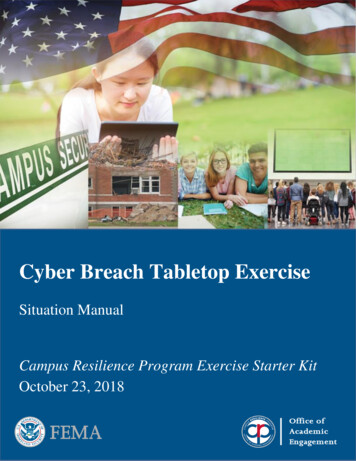
Transcription
Cyber Breach Tabletop ExerciseSituation ManualCampus Resilience Program Exercise Starter KitOctober 23, 2018
Campus Resilience ProgramCyber Breach Tabletop ExerciseSituation ManualHANDLING INSTRUCTIONSThe title of this document is the Cyber Breach Tabletop Exercise (TTX) Situation Manual. This documentshould be safeguarded, handled, transmitted, and stored in accordance with appropriate security directives.Reproduction of this document, in whole or in part, is prohibited without prior approval from the exerciseplanning team. This document has been marked as “FOR DISCUSSION PURPOSES ONLY.”For more information on this exercise, please consult the following point of contact:Cheryl DowdCyber FellowWICHEWCET(303)541-0210cdowd@wiche.eduiFOR DISCUSSION PURPOSES ONLY
Campus Resilience ProgramCyber Breach Tabletop ExerciseSituation ManualTABLE OF CONTENTSHandling Instructions . iTable of Contents . iiAgenda . iiiOverview . 1General Information . 2Introduction . 2Overview . 2Objectives and Core Capabilities . 2Participant Roles and Responsibilities . 3Exercise Structure. 3Exercise Guidelines . 4Assumptions and Artificialities . 4Module 1: Initial Response . 5Background. 5Scenario . 5Discussion Questions. 5Module 2: Extended Response . 8Scenario . 8Discussion Questions. 8Module 3: Short-Term Recovery . 11Scenario . 11Discussion Questions. 11Appendix A: Relevant Plans . A-Error! Bookmark not defined.Appendix B: Participating Organizations .B-Error! Bookmark not defined.Appendix C: Acronyms . C-2Appendix D: Glossary. D-1iiFOR DISCUSSION PURPOSES ONLY
Campus Resilience ProgramCyber Breach Tabletop ExerciseSituation ManualAGENDACyber Breach Tabletop Exercise10/23/18; 9:00amWCET Annual Meeting Precon – Portland, Oregon*Note that the typical tabletop exercise consists of the following schedule for a 4 - hour exercise. This is anabridged version to share the basic elements of tabletop exercises with the participantsWelcome and Introductions [Recommended Time: 5 Minutes]Exercise Overview [Recommended Time: 10 Minutes]Module 1: Initial Response [Recommended Time: 60 Minutes]Break [Recommended Time: 10 Minutes]Module 2: Extended Response [Recommended Time: 60 Minutes]Break [Recommended Time: 10 Minutes]Module 3: Short-Term Recovery [Recommended Time: 60 Minutes]Exercise Hot Wash [Recommended Time: 15 Minutes]Closing Comments [Recommended Time: 10 Minutes]iiiFOR DISCUSSION PURPOSES ONLY
Campus Resilience ProgramCyber Breach Tabletop ExerciseSituation ManualOVERVIEWExercise NameExercise DateScopeMission AreasObjectivesScenarioCyber Breach Tabletop Exercise10/23/18; 9:00 AM – 11:00 AMThis exercise is a discussion-based “abridged” tabletop exercise, planned fortwo hours at the WCET Annual Meeting Precon. Divided into three Modules,this exercise will examine response and recovery operations related to a cyberbreach targeted against institutional data.Response and Recovery1. Operational Coordination: Assess the ability to establish an effectivecommand structure that integrates all critical stakeholders to ensurecampus and community resources are used efficiently to respond to andrecover from a cyber incident2. Cybersecurity: Evaluate existing capabilities to protect and restoreelectronic systems, networks, information, and services from damage,unauthorized use, and exploitation during a cyber incident3. Situational Awareness: Examine the ability to provide timely andrelevant information regarding the cyber incident to critical campus andcommunity decision-makers4. Public Information and Warning: Assess the ability to delivercoordinated, actionable, and timely information to critical partners andstakeholders when faced with a cyber incident targeting institutionaloperationsThe exercise scenario will include a cyber breach that results in thecompromise of personal and institutional data. ionPoint of Contact WICHE WCETCooley, LLPWCETCheryl Dowd, Cyber Fellow, WICHE(303)541-0210, cdowd@wiche.edu1FOR DISCUSSION PURPOSES ONLY
Campus Resilience ProgramCyber Breach Tabletop ExerciseSituation ManualGENERAL INFORMATIONIntroductionThis document serves as the Cyber Breach Tabletop Exercise Situation Manual (SitMan). It includes theexercise goals and objectives, scenario details, as well as discussion questions for use during the exercise.In addition to aligning with the National Preparedness Goal, the content contained in this SitMan has beendesigned in accordance with Homeland Security Exercise and Evaluation Program (HSEEP) doctrine.OverviewThe U.S. Department of Homeland Security (DHS), Office of Academic Engagement (OAE) is pleased tosupport the Cyber Breach Tabletop Exercise as part of the broader Campus Resilience (CR) ProgramExercise Starter Kits. This Exercise Starter Kit was made possible through collaboration and coordinationwith the Federal Emergency Management Agency (FEMA) National Exercise Division (NED).The broader purpose of each Exercise Starter Kit offered through the CR Program is to support practitionersand senior leaders from the academic community in assessing emergency plans, policies, and procedureswhile also enhancing overall campus resilience. Specifically, this Exercise Starter Kit will provide theopportunity to examine response and recovery operations related to a cyber breach targeting criticalinstitutional data and information.Objectives and Core CapabilitiesThe objectives in Table 1 describe the expected outcomes for this exercise. The objectives are linked tocore capabilities, which are distinct critical elements necessary to achieve the specific mission area(s).Table 1: Exercise Objectives and Core CapabilitiesExercise ObjectiveCore Capability1. Assess the ability to establish an effectivecommand structure that integrates all criticalstakeholders to ensure campus and communityresources are used efficiently to respond to andrecover from a cyber incident Operational Coordination2. Evaluate existing capabilities to protect and restoreelectronic systems, networks, information, andservices from damage, unauthorized use, andexploitation during a cyber incident Cybersecurity3. Examine the ability to provide timely and relevantinformation regarding the cyber incident to criticalcampus and community decision-makers Situational Awareness4. Assess the ability to deliver coordinated,actionable, and timely information to criticalpartners and stakeholders when faced with a cyberincident targeting institutional operations Public Information and Warning2FOR DISCUSSION PURPOSES ONLY
Campus Resilience ProgramCyber Breach Tabletop ExerciseSituation ManualPARTICIPANT INFORMATION AND GUIDANCEParticipant Roles and ResponsibilitiesThe term participant encompasses many groups of people, not just those playing in the exercise. Groups ofparticipants involved in the exercise, and their respective roles and responsibilities, are detailed below.Facilitator(s)The Facilitator will guide exercise play and is responsible for ensuring that participant discussions remainfocused on the exercise objectives. They provide additional information and resolve questions as required.They are also responsible for making sure everyone is included in the conversation and has the opportunityto participate.PlayersPlayers have an active role in discussing their preparedness, response, and recovery activities during theexercise. Players should discuss or initiate actions based on the simulated exercise scenario.ObserversObservers may visit or view selected segments of the exercise but do not actively engage in exercisediscussions.Support StaffThe exercise support staff includes individuals who perform administrative and logistical support tasksduring the exercise (e.g., registration, catering, etc.).Exercise StructureThe Cyber Breach Tabletop Exercise will consist of three, [insert duration]-minute Modules that focus onresponse and recovery operations. Each Module will consist of two separate activities: a scenario overviewand facilitated discussions. The exercise facilitator will first provide an overview of the scenario and willthen engage participants in facilitated discussions around a set of questions. Discussions should focus onkey actions, activities, and decisions that each player would perform given the specific scenario conditions.The three exercise Modules include: Module 1 will focus on immediate response operations four hours following the initial notificationof a cyber breach Module 2 will focus on extended response operations up to 36 hours following the notification ofa cyber breach Module 3 will focus on short-term recovery operations seven days following the notification of acyber breachThe approximate duration of each exercise activity is noted in Table 2 below.3FOR DISCUSSION PURPOSES ONLY
Campus Resilience ProgramCyber Breach Tabletop ExerciseSituation ManualTable 2: Module StructureModule 1Module 2Module 3Total Minutes15 Minutes15 Minutes15 MinutesScenario Review10 Minutes10 Minutes10 MinutesFacilitated Discussions5 Minutes5 Minutes5 MinutesExercise GuidelinesThis exercise will incorporate a scenario-based format guided by the event objectives. The Modules andassociated discussion questions support achievement of the objectives by initiating discussions, facilitatingdecision-making, and assisting participants in the arrival of appropriate response outcomes. This approachallows the discussions to focus on situations within a moving timeline and for participants to contribute tothe discussion from the perspective of their role in the scenario. The Facilitator will ensure that the scenariomoves along at an appropriate pace and that all participants have an opportunity to contribute.Assumptions and ArtificialitiesAssumptionsAssumptions are the implied factual foundation for the exercise and are assumed to be present before theexercise starts. The following assumptions apply to the exercise: Exercise players will use existing plans, policies, procedures, and resources to guide responsesParticipants may need to balance exercise play with real-world emergencies; real-worldemergencies take priorityArtificialitiesDuring this exercise, the following artificialities apply: The scenario is plausible, and events occur as they are presentedThere is no “hidden agenda” nor are there any trick questionsThe scenario assumes certain player actions as it moves through each phase; players should firstdiscuss the actions stipulated by the scenarioPlayers are welcome to engage in “what if” discussions of alternative scenario conditions4FOR DISCUSSION PURPOSES ONLY
Campus Resilience ProgramCyber Breach Tabletop ExerciseSituation ManualMODULE 1: INITIAL RESPONSEBackgroundIn recent years, malicious cyber actors have targeted institutions ofhigher education (IHEs) with typical cybercrime activities. Theseinclude spear-phishing students and faculty with institutionthemed messages, creating fake websites, and infecting computerswith malicious software – often in an attempt to gain access tostudent and faculty emails, personally identifiable information(PII), as well as financial records and payment systems.While malicious cyber actors continue to exploit institutionalFigure 1: Cyber Security Personnelnetworks for financial gain, an emerging threat facing IHEs isindividuals conducting cyber espionage. In addition to innovative scientific and medical research, collegesand universities are often involved in sensitive government and private sector research projects. Theseassociations are very appealing to cyber espionage actors looking to gain access to sensitive programs andexfiltrate information. Institutional networks, which often have multiple levels of connectivity andaccessibility to encourage and enable collaboration, may present an easier target for cyber espionage actorsthan sensitive government or private industry networks. Furthermore, institutions may be at a higher riskdue to a lack of cyber security awareness among students, faculty, and staff.ScenarioOctober 26, 2018 10:00amYour institution’s Chief Information Security Officer (CISO) is contacted by a Special Agent from theCyber Division of the Federal Bureau of Investigation (FBI). The agent states that a cyber attack has beenlaunched against your institution’s network by an outside entity. At this time, the precise duration, scope,and source of the attack are not completely clear. Working in collaboration with the FBI, the initialinvestigation quickly reveals the presence of an advanced persistent threat (APT) that appears to beconsistent with sophisticated malware that has been previously used by individuals to access criticalinstitution data and proprietary information.October 26, 2018 2:00pmBy this time, enough evidence is discovered to determine the attack was initiated at least three months prior,and during that time, attackers had free and unlimited access to all networks, databases, servers, and othersensitive resources associated with various departments and colleges. While exfiltration of data cannot beconfirmed now, it is reasonable to assume sensitive information has been compromised. While the attackappears to specifically target PII data within your institutions departments and colleges, a thorough analysisof the entire institution network is underway. It is anticipated this process may take several days to completeDiscussion QuestionsOperational Coordination1. What plans, policies, and procedures does your institution have in place to respond to the effectsof a data breach?2. What are your institution’s initial priorities?5FOR DISCUSSION PURPOSES ONLY
Campus Resilience ProgramCyber Breach Tabletop ExerciseSituation Manual3. How would your institution establish a command structure to coordinate your immediate responseefforts?a. Who are your key internal and external stakeholders and how would your institutionincorporate them into this command structure?b. How can your institution coordinate with private and public partners to ensure a unifiedresponse effort?4. What resource gaps could limit your institution’s ability to respond to a cyber attack?a. What community resources and aid agreements could compensate for these resource gaps?Cybersecurity1. Does your institution have a formalized cyber incident response plan?a. Does your plan clearly outline what individuals/positions are involved in response effortsand how they are expected to coordinate with one another?b. Do you periodically test your plan and train staff?c. Does your institution currently have cyber insurance? If so, at what point would you notifyyour provider of a potential breach? If not, what other financial plans do you have in placeto offset potential costs of this type of incident?2. Does your institution’s response strategy outline how to align broader response efforts with ongoingsecurity management and IT efforts?3. What steps will your institution take to verify the likelihood of a data breach resulting in the releaseof PII?a. How does your institution determine what systems/data/services may have been breached?4. What measures are in place to protect confidential, personal, financial, and academic informationconcerning students, faculty, staff, and alumni from a potential cyber incident?a. Are these existing protective measures, or measures that would be implementedfollowing a cyber incident?Situational Assessment1. How does your institution collect, verify, and analyze information immediately followingawareness of, or notification of a cyber incident?2. How do you conduct initial decision-making and offer decision-making recommendations tosenior leadership?3. Do you have identified information requirements that support leadership decision-makingprocesses (e.g., type of cyber incident, scope of incident, numbers of individuals impacted,implementation of cyber response plan)?Public Information and Warning1. What plans, policies, and procedures does your institution have in place to guide communicationswith potentially affected parties at this time?a. What internal and external stakeholders are you engaging?b. What information would you release and how?c. How does your institution use pre-scripted or automated messaging that would expeditecritical communications?2. What individual, office, or department coordinates and delivers your institution’s messaging?6FOR DISCUSSION PURPOSES ONLY
Campus Resilience ProgramCyber Breach Tabletop ExerciseSituation Manual3. How will your institution use social media platforms in support of incident communications andmessaging?4. At this point in the scenario, would your institution notify non-affected members of the campuscommunity?7FOR DISCUSSION PURPOSES ONLY
Campus Resilience ProgramCyber Breach Tabletop ExerciseSituation ManualMODULE 2: EXTENDED RESPONSEScenarioOctober 26, 2018 10:00 pmA second intrusion has been detected on the network. Whileinvestigating the initial breach, a malware variant known to be used bycyber criminals to harvest and exfiltrate PII was discovered on severalcomputers, to include workstations in the Office of Human Resources,the Admissions and Registration Offices, and the Financial Aid andScholarship Offices.October 27, 2018 10:00 amFigure 2: Data Center ServerA detailed review of internal logging systems indicates stolenemployee login credentials may have been used to access databases containing both student and facultyrecords. Further examination of server logs indicates large amounts of student, faculty, and staff data hasbeen exfiltrated over the past several months. Evidence indicates the stolen data includes the name, address,date of birth, and social security number for students, faculty, and staff (domestic and international) from2012 to the present.October 27, 2018 10:00 pmLocal news outlets begin contacting your institution’s public affairs office. Reporters indicate they haveheard there has been a data breach at your institution and that personal information for hundreds of students,faculty, and staff has been stolen and is being used on the dark web. They want to know the extent of thebreach.Concerned students and parents begin inundating your institution’s phone lines requesting additionalguidance on the status of their information as well as the extent of the potential breach.Discussion QuestionsOperational Coordination1. What plans, policies, and procedures does your institution have in place to guide response effortsat this point?a. What are your mid-term response priorities?2. How would your institution maintain an effective command structure to coordinate cyber responseefforts?a. Who are the key decision-makers at this point?b. What are their specific roles and responsibilities?3. How do key decision-makers collect information on system damages and critical needs?4. What resources are currently available to support response efforts?a. What plans, agreements, and contingency contracts are in place to address potential systemissues?5. Who are the key external stakeholders that would support response efforts?8FOR DISCUSSION PURPOSES ONLY
Campus Resilience ProgramCyber Breach Tabletop ExerciseSituation Manuala. How would your institution coordinate and communicate with these stakeholders?Cybersecurity1. What tools are in place to prevent the remote extraction of information from a network byunauthorized users?a. Who is responsible for assisting the security of the network?b. How often are security tests completed?2. Do you currently possess sufficient capabilities in-house to investigate and mitigate a potentialincident of this type?a. If not, what stakeholders would you engage to address capability gaps?3. What types of impacts could your institution expect from the potential loss of PII?a. At this point, do you envision any financial and legal consequences?4. What plans, policies, and procedures exist to ensure students, faculty, and staff engage ininformation security best practices?a. Who determines these organizational best practices?b. How are students, faculty, and staff educated about these practices?Situational Assessment1. Have your information needs changed during this phase of the response?a. How are you collecting critical information at this time?b. Who do you receive this information from and who do you disseminate this informationto?c. How are you analyzing and disseminating this information?2. What are the processes for communication and coordination between internal and externalpartners to support any emerging needs or response requirements?3. Are there identified reporting requirements for internal stakeholders? For external partners? Forleadership and key decision-makers?a. What, if any, federal, state, or local reporting requirements must you comply with ifimpacted by a cyber incident?b. Who within your institution is responsible for fulfilling these reporting requirements?Public Information and Warning1. At this point in the scenario, how would your institution be communicating with potentially affectedas well as non-affected parties?a. What would your messaging priorities be at this point?b. How would your institution ensure messaging is consistent and coordinated throughout theresponse period?c. Who is responsible for delivering this messaging?9FOR DISCUSSION PURPOSES ONLY
Campus Resilience ProgramCyber Breach Tabletop ExerciseSituation Manuald. How does this messaging accommodate international students and families as well asstudents with access and functional needs?2. How does your institution ensure timely and accurate situational updates for external stakeholders(e.g., media) throughout the response period?a. Who is responsible for delivering these updates?b. What sort of information is your institution releasing at this point?3. Does your institution have a crisis communications plan or other means of communicating with allstakeholders in case of a disruption or corruption of standard communications?a. How and when does your institution activate its crisis communications plan?10FOR DISCUSSION PURPOSES ONLY
Campus Resilience ProgramCyber Breach Tabletop ExerciseSituation ManualMODULE 3: SHORT-TERM RECOVERYScenarioNovember 2, 2018 10:00 amA full and thorough analysis of the entire network and associated serverlogs reveals that the scope of the data breach may be more extensivethan previously suspected and may also include health-related data anddonor information.While still working through the repercussions and effects of the breach,many students, faculty, and staff members express concerns regardingtheir information and request guidance on what your institution is doingto protect their data.Figure 3: Media PersonnelMedia outlets continue to report on the breach. Many cyber expertscriticize the way your institution has handled the situation and aresuggesting that your slow response allowed for wider system impacts.Discussion QuestionsOperational Coordination1. How does your institution coordinate the transition from response to short-term recovery efforts?2. What plans, policies, and procedures guide your institution’s recovery process?a. Who is responsible for coordinating short- and long-term recovery efforts?b. What are your institution’s priorities for short-term recovery?3. What resource gaps could limit your institution’s ability to meet these priorities?a. What community resources or aid agreements could compensate for those gaps?Cybersecurity1. What partnerships does your institution have to support recovery efforts (e.g., cyber insurance) inthe aftermath of a cyber incident?a. If none, how would your institution formalize partnerships with the necessarystakeholders?b. Who at your institution would be responsible for coordinating these efforts?2. What are your institution’s plans for the recovery and restoration of critical systems and data thathave been compromised as a result of a cyber related incident?3. What strategies would be implemented to mitigate potential negative impacts resulting from stolenand/or leaked PII?a. If you have an established cyber incident response plan, how does it provide guidance forthis type of incident recovery?4. What future cybersecurity measures could you implement to develop more secure systems andprotect critical institutional data from a future breach?11FOR DISCUSSION PURPOSES ONLY
Campus Resilience ProgramCyber Breach Tabletop ExerciseSituation ManualSituational Assessment1. What critical decisions would need to be made at this point to inform recovery efforts?a. What are the long-term financial implications of a breach of this nature for yourinstitution?2. What legal obligations exist, if any, that may affect how intelligence and information is processedand communicated following a cyber related incident?a. How are these legal obligations accounted for in overall recovery efforts?b. What stakeholders would likely be involved in this information sharing?3. Following this type of incident, what decisions or actions would you take to maintain public andinstitutional confidence?a. What internal or external partners would be engaged in this process?b. What leadership decisions would support this process?Public Information and Warning1. How does your institution ensure consistent, coordinated messaging throughout the recoveryperiod?a. How does your institution’s communications strategy transition from response-oriented torecovery-oriented messaging?b. Who is responsible for monitoring and managing inquiries from students, faculty, staff,and alumni?c. How does this messaging accommodate international audiences as well as those withaccess and functional needs?2. How does your institution provide external stakeholders (e.g., media) with timely updatesconcerning recovery efforts?3. How would you maintain overall brand reputation for an incident involving a cyber breach?a. How would potentially false or misleading information be handled?b. How would potentially sensitive or classified information be handled?4. How are students, faculty, and staff briefed on protective actions and measures to prevent futurecyber incidents?12FOR DISCUSSION PURPOSES ONLY
Campus Resilience ProgramCyber Breach Tabletop ExerciseSituation ManualNOTESB-1FOR DISCUSSION PURPOSES ONLY
Campus Resilience ProgramCyber Breach Tabletop ExerciseSituation ManualAPPENDIX A: ACRONYMSAcronymTermAPTAdvanced Persistent ThreatCISOChief Information Security OfficerCR ProgramCampus Resilience ProgramDHSDepartment of Homeland SecurityFBIFederal Bureau of InvestigationFEMAFederal Emergency Management AgencyHSEEPHomeland Security Exercise and Evaluation ProgramIHEInstitution of Higher EducationITInformation TechnologyNEDNational Exercise DivisionOAEOffice of Academic EngagementPIIPersonally Identifiable InformationSitManSituation ManualTTXTablet
due to a lack of cyber security awareness among students, faculty, and staff. Scenario October 26, 2018 10:00am Your institution's Chief Information Security Officer (CISO) is contacted by a Special Agent from the Cyber Division of the Federal Bureau of Investigation (FBI). The agent states that a cyber attack has been
